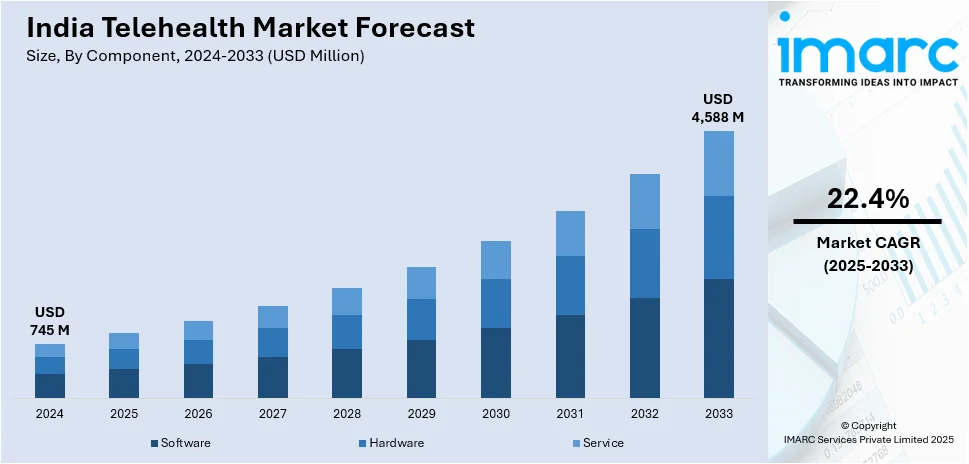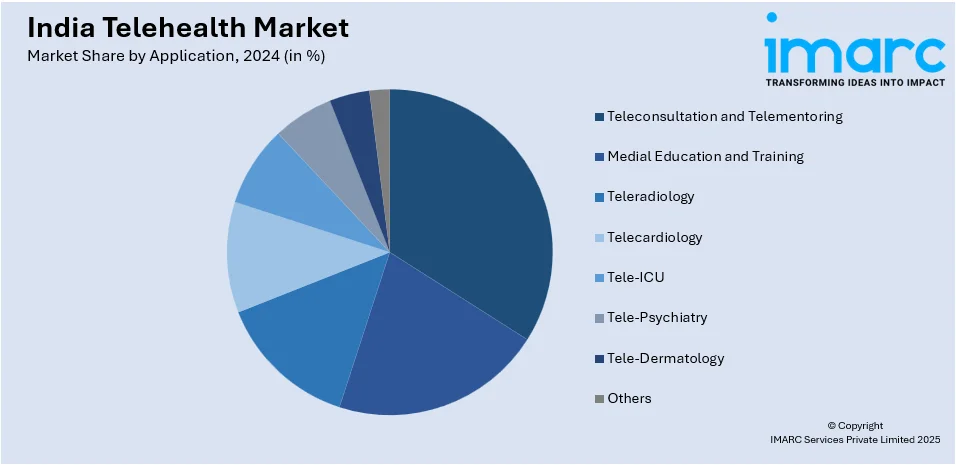
India Telehealth Market Size, Share, Trends and Forecast by Component, Communication Technology, Hosting Type, Application, End User, and Region, 2025-2033
Market Overview:
The India telehealth market size reached USD 745 Million in 2024. Looking forward, IMARC Group expects the market to reach USD 4,588 Million by 2033, exhibiting a growth rate (CAGR) of 22.4% during 2025-2033. The increasing demand for healthcare services, government support for digital healthcare initiatives, smartphone, and internet penetration, the impact of the COVID-19 pandemic, and a bolstering healthcare IT industry represent some of the key factors driving the market.
|
Report Attribute
|
Key Statistics
|
|---|---|
|
Base Year
|
2024 |
|
Forecast Years
|
2025-2033
|
|
Historical Years
|
2019-2024
|
| Market Size in 2024 | USD 745 Million |
| Market Forecast in 2033 | USD 4,588 Million |
| Market Growth Rate (2025-2033) | 22.4% |
Telehealth, also known as telemedicine, is a healthcare delivery model that involves the use of telecommunications technology to provide medical services remotely. It allows healthcare professionals to interact with patients in real time through video conferencing, phone calls, or other digital communication tools, regardless of geographical barriers. The aim of telehealth is to enhance access to healthcare services, improve patient outcomes, and reduce healthcare costs. In telehealth, patients can consult with physicians, specialists, or other healthcare providers from the comfort of their homes or any other convenient location using their smartphones, tablets, or computers. This method of healthcare delivery is particularly beneficial for individuals in rural or underserved areas, where access to healthcare facilities may be limited. Telehealth services encompass various medical consultations, including general health check-ups, mental health counseling, chronic disease management, and follow-up appointments. Apart from this, telehealth has proven to be instrumental in delivering timely medical assistance during emergencies or natural disasters when traditional healthcare systems might be compromised.

To get more information on this market, Request Sample
India Telehealth Market Trends:
The Indian telehealth market is being driven by the increasing demand for healthcare services and the growing burden of diseases, which has necessitated the expansion of healthcare access to remote and underserved regions. Besides this, numerous favorable initiatives by the Government of India (GOI), such as the National Digital Health Mission (NDHM) and the establishment of the Health Ministry's Telemedicine Practice Guidelines, promoting digital healthcare, are creating a favorable outlook for market expansion. Moreover, the availability of affordable smartphones and low-cost data plans has enabled a significant portion of the population to access digital devices and internet connectivity. This, in turn, has facilitated the widespread adoption of telehealth platforms and mobile health applications, enabling individuals to seek medical advice and consultations remotely, thereby reducing the burden on traditional healthcare facilities. In addition to this, the need to maintain social distancing and reduce the spread of virus during the COVID-19 pandemic has acted as a catalyst for the telehealth market in India, fueling the adoption of virtual healthcare consultations. Furthermore, the flourishing healthcare IT industry of the country, coupled with a growing number of startups specializing in innovative telehealth solutions, including AI-driven diagnostics, remote monitoring devices, and data analytics, are contributing to the market's growth.
India Telehealth Market Segmentation:
IMARC Group provides an analysis of the key trends in each segment of the India telehealth market report, along with forecasts at the country level for 2025-2033. Our report has categorized the market based on component, communication technology, hosting type, application, and end user.
Component Insights:
- Software
- Hardware
- Service
The report has provided a detailed breakup and analysis of the market based on the component. This includes software, hardware, and service.
Communication Technology Insights:
- Video Conferencing
- mHealth Solutions
- Others
A detailed breakup and analysis of the market based on communication technology has also been provided in the report. This includes video conferencing, mHealth solutions, and others.
Hosting Type Insights:
- Cloud-Based and Web-Based
- On-Premises
The report has provided a detailed breakup and analysis of the market based on the hosting type. This includes cloud-based and web-based, and on-premises.
Application Insights:

- Teleconsultation and Telementoring
- Medial Education and Training
- Teleradiology
- Telecardiology
- Tele-ICU
- Tele-Psychiatry
- Tele-Dermatology
- Others
A detailed breakup and analysis of the market based on the application has also been provided in the report. This includes teleconsultation and telementoring, medial education and training, teleradiology, telecardiology, tele-ICU, tele-psychiatry, tele-dermatology, and others.
End User Insights:
- Providers
- Patients
- Payers
- Others
The report has provided a detailed breakup and analysis of the market based on the end user. This includes providers, patients, payers, and others.
Regional Insights:
- South India
- North India
- West and Central India
- East India
The report has also provided a comprehensive analysis of all the major regional markets, which include South India, North India, West and Central India, and East India.
Competitive Landscape:
The report has also provided a comprehensive analysis of the competitive landscape in the market. Competitive analysis such as market structure, key player positioning, top winning strategies, competitive dashboard, and company evaluation quadrant has been covered in the report. Also, detailed profiles of all major companies have been provided.
India Telehealth Market Report Coverage:
| Report Features | Details |
|---|---|
| Base Year of the Analysis | 2024 |
| Historical Period | 2019-2024 |
| Forecast Period | 2025-2033 |
| Units | Million USD |
| Scope of the Report | Exploration of Historical and Forecast Trends, Industry Catalysts and Challenges, Segment-Wise Historical and Predictive Market Assessment:
|
| Components Covered | Software, Hardware, Service |
| Communication Technologies Covered | Video Conferencing, mHealth Solutions, Others |
| Hosting Types Covered | Cloud-Based and Web-Based, On-Premises |
| Applications Covered | Teleconsultation and Telementoring, Medial Education and Training, Teleradiology, Telecardiology, Tele-ICU, Tele-Psychiatry, Tele-Dermatology, Others |
| End Users Covered | Providers, Patients, Payers, Others |
| Regions Covered | South India, East India, West and Central India, North India |
| Customization Scope | 10% Free Customization |
| Post-Sale Analyst Support | 10-12 Weeks |
| Delivery Format | PDF and Excel through Email (We can also provide the editable version of the report in PPT/Word format on special request) |
Key Benefits for Stakeholders:
- IMARC’s report offers a comprehensive quantitative analysis of various market segments, historical and current market trends, market forecasts, and dynamics of the India telehealth market from 2019-2033.
- The research study provides the latest information on the market drivers, challenges, and opportunities in the India telehealth market.
- Porter's five forces analysis assist stakeholders in assessing the impact of new entrants, competitive rivalry, supplier power, buyer power, and the threat of substitution. It helps stakeholders to analyze the level of competition within the India telehealth industry and its attractiveness.
- Competitive landscape allows stakeholders to understand their competitive environment and provides an insight into the current positions of key players in the market.
Key Questions Answered in This Report
The telehealth market in India was valued at USD 745 Million in 2024.
The India telehealth market is projected to exhibit a CAGR of 22.4% during 2025-2033, reaching a value of USD 4,588 Million by 2033.
The India telehealth market is propelled by growing demand for accessible and affordable healthcare, particularly in rural areas, rising penetration of smartphone/internet, and a shortage of doctors. Supportive government initiatives (like eSanjeevani) and technological advancements (AI, remote monitoring) further accelerate its growth.
Need more help?
- Speak to our experienced analysts for insights on the current market scenarios.
- Include additional segments and countries to customize the report as per your requirement.
- Gain an unparalleled competitive advantage in your domain by understanding how to utilize the report and positively impacting your operations and revenue.
- For further assistance, please connect with our analysts.
 Request Customization
Request Customization
 Speak to an Analyst
Speak to an Analyst
 Request Brochure
Request Brochure
 Inquire Before Buying
Inquire Before Buying




.webp)




.webp)












